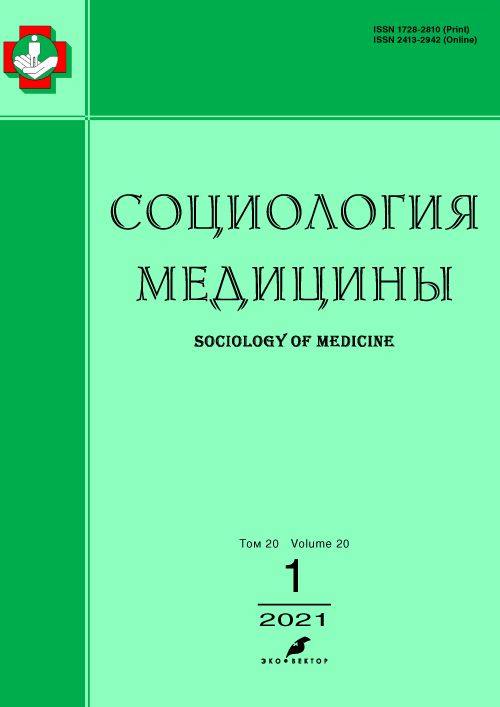Personnel development potential of the regional health system represented by health care organizers: based on the results of an expert focus group study
- Authors: Eremina M.G.1, Kovalev E.P.1, Krom I.L.1, Erugina M.V.1, Lipchanskaya T.P.1
-
Affiliations:
- V.I. Razumovsky Saratov State Medical University
- Issue: Vol 20, No 1 (2021)
- Pages: 13-20
- Section: Articles
- URL: https://rjsocmed.com/1728-2810/article/view/100343
- DOI: https://doi.org/10.17816/1728-2810-20-1-15
- ID: 100343
Cite item
Abstract
The article analyzed personnel crisis problem in the modern healthcare system in Russia on the basis of the results of a focus group study. Accordingly, the formation and severity of the crisis at both regional and national healthcare system are influenced by the migration of medical personnel (from one regional center to another, other Russian regions, and overseas), disproportion in the number of doctors of some clinical specialties (such as dentists and dermatovenerologists) over the actual staffing needs of a regional health center, and shortage of middle and junior medical personnel in regional medical organizations that leads to an increase in the burden on doctors, and existing discrepancies between the requirements of the labor market in terms of work experience among young specialists and its actual absence among graduates of medical universities.
Full Text
About the authors
Marina G. Eremina
V.I. Razumovsky Saratov State Medical University
Author for correspondence.
Email: 913693@mail.ru
ORCID iD: 0000-0001-9752-1352
MD, Cand. Sci. (Med.)
Russian Federation, 8, Bolshaya Kazachia str., Saratov, 410012Evgeniy P. Kovalev
V.I. Razumovsky Saratov State Medical University
Email: kovalevevgeni2005@yandex.ru
ORCID iD: 0000-0002-7725-3036
Russian Federation, Saratov
Irina L. Krom
V.I. Razumovsky Saratov State Medical University
Email: irina.crom@yandex.ru
ORCID iD: 0000-0003-1355-5163
Russian Federation, Saratov
Marina V. Erugina
V.I. Razumovsky Saratov State Medical University
Email: lab48@yandex.ru
ORCID iD: 0000-0003-4253-5313
Russian Federation, Saratov
Tatiyana P. Lipchanskaya
V.I. Razumovsky Saratov State Medical University
Email: lab48@yandex.ru
ORCID iD: 0000-0002-7755-1834
Russian Federation, Saratov
References
- Reshetnikov AV. The social institution of medicine. Part II. Sociology of medicine. 2018;17(2):68-79.
- Reshetnikov AV. Sovremennye podkhody k otsenke vzaimootnoshenii mezhdu patsientom i vrachom, meditsinskoi organizatsiei, strakhovoi meditsinskoi organizatsiei. Proceedings of the Russian science conference «Sotsial’naya rol’ vracha v rossiiskom obshchestve»; 2018 May 30; Nizhnii Novgorod. (In Russ).
- Lindenbraten AL. Topical problems of Russian healthcare. Bulletin of Semashko National Research Institute of Public Health. 2020;(3):60-71. doi: 10.25742/NRIPH.2020.03.008 (In Russ).
- Vyatkina NY, Prisyazhnaya NV, Wasserman BA. The labor employment of graduates of medical universities: the main discourses of investigation. Sociology of medicine. 2018;17(2):88-97.
- Khal’fin RA, Kakorina EP, Ignat’eva MV, et al. Otsenka effektivnosti deyatel’nosti organov gosudarstvennoi vlasti v sfere zdravookhraneniya RF. Moscow: GEOTAR-Media; 2013. (In Russ).
- Ulumbekova GE. The program of urgent measures in the healthcare sector of the russian federation to overcome the systemic crisis. Healthcare management: news. Views. Education. Bulletin of vshouz. 2020;6(1):4–16.
- Drennan VM, Ross F. Global nurse shortages-the facts, the impact and action for change. Br Med Bull. 2019;130(1):25-37.
- Naicker S, Plange-Rhule J, Tutt RC, Eastwood JB. Shortage of healthcare workers in developing countries--Africa. Ethn Dis. 2009;19(1 Suppl 1):S1-60-64.
- Kroezen M, Schafer W, Sermeus W, et al. Healthcare assistants in EU Member States: An overview. Health Policy. 2018;122(10):1109-1117.
- Hamdy H. The Problem and Goals Are Global, the Solutions Are Local: Revisiting Quality Measurements and the Role of the Private Sector in Global Health Professions Education. Acad Med. 2017;92(8):1082-1085.
- Birch S. Demand-based models and market failure in health care: projecting shortages and surpluses in doctors and nurses. Health Econ Policy Law. 2019;14(2):291-294.
- Ariste R. Availability of health workforce in urban and rural areas in relation to Canadian seniors. Int J Health Plann Manage. 2019;34(2):510-520.
- Sheiman IM, Sazhina SV. Human Resource Policies in the System of Health Provision: Overcoming the Shortage of Physicians. “Universe of Russia” (Mir Rossii). 2018;27(3):130-153. doi: 10.17323/1811-038X-2018-27-3-130-153 (In Russ).
- Sheiman IM, Shevsky VI, Sazhina SV. Prioritet pervichnoi mediko-sanitarnoi pomoshchi — deklaratsiya ili real’’nost’’? Social aspects of population health. 2019;(1):3. doi: 10.21045/2071-5021-2019-65-1-3 (In Russ).
- Yadov VA. Strategiya sotsiologicheskogo issledovaniya. Opisanie, ob”yasnenie, ponimanie sotsial’noi real’nosti. Мoscow: Omega-L; 2007. (In Russ).
- Prisyazhnaya NV. Meditsina v mire budushchego: gruz traditsii i press novatsii? In: Sotsiologiya i obshchestvo: traditsii i innovatsii v sotsial’nom razvitii regionov. Sbornik dokladov VI Vserossiiskogo sotsiologicheskogo kongressa. Tyumen’; 2020. P:2616–2623. doi: 10.19181/kongress.2020 (In Russ).
- Beran RG, Pereira A, Barbosa C, et al. Legal Regulation and Role of Telemedicine in Australia, Portugal and Russia. Medicine and Law. 2019;38(4):677-710.
- Panova EL. The categories of health and disease in evolution of paradigms of medicine. Sociology of medicine. 2019;18(2):110-117.
Supplementary files







